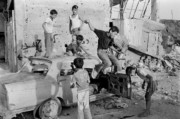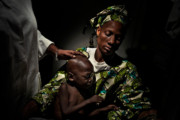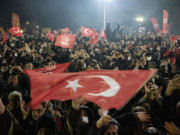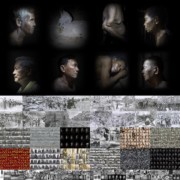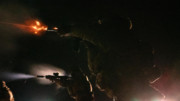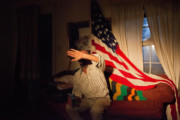Fight or Flee: The Price of Freedom
Chien-Chi Chang’s three-year chronicle of the Russia-Ukraine War, in his own words.
The city was almost unrecognizable when I arrived in Odesa on a chilly mid-November evening. Darkness engulfed the streets, broken only by the faint flicker of candles in apartment windows, the muted glow of passing headlights, and the relentless hum of diesel generators. The acrid smell of fuel clung to the air, and the noise was inescapable — like an unending cacophony of lawnmowers cutting through an eerie, oppressive silence.
Power rationing here isn’t an inconvenience — it’s a fight for survival. After three years of relentless Russian attacks on Ukraine, including the energy grid, half of the country’s power capacity has been destroyed. Like much of Ukraine, Odesa is left to endure nights of cold and darkness.
My fixer, Oleksiy, had booked me into the Atlantic Hotel. Once a lively garden resort by the seaport, it felt like a hollow shell of its former self. The lobby was dim and nearly empty. Some staff were already curled up on sofas with blankets, settling in for the night. It was more shelter than hotel now, a reminder of how deeply the war had eroded the simplest comforts of life.
Just as I was about to board my flight from Vienna to Chisinau, my phone buzzed with a text from my editor friend, Peter, of Kyiv’s Interfax News Service:
“Have a safe trip. Yeah, watch out for cruise missiles.”
This is my ninth self-financed trip to Ukraine since the full-scale invasion began in February 2022, yet I still feel like a beginner. Every time, it’s the same seat-of-the-pants approach. Nothing feels routine because this is war — situations change instantly, schedules are re-scheduled at the last minute, and uncertainty is the only constant.
The first time Oleksiy and I met for coffee, it was a brief but revealing moment. Without discussion, we instinctively chose seats facing the entrance — a habit I’d developed working in New York’s Chinatown in 1992 and, for Oleksiy, a wartime necessity. Over our shoulders hung our mini EDC (Everyday Carry) bags, always prepared for the unexpected.
Oleksiy, a filmmaker turned fixer, is renowned for his meticulous caution. His worn but sturdy Nissan Pathfinder is a fortress on wheels, equipped with a drone spotter and stocked with survival essentials like first-aid kits and tactical tools. His secluded studio doubles as a bunker, with shelves of canned food, water, and sleeping bags neatly stacked alongside charged walkie-talkies to sustain five people for two weeks. It’s more than a workspace — it’s a lifeline.
"This is my ninth self-financed trip to Ukraine since the full-scale invasion began in February 2022, yet I still feel like a beginner."
-
The importance of readiness hit home in Kyiv when a sudden power outage plunged us into darkness inside a cramped, one-square-meter Soviet-era elevator. The scratched metal walls and the cold, stale air made the moment even more claustrophobic. It was a stark reminder of how quickly routine can turn dangerous. Here, caution isn’t just a virtue — it’s an essential survival skill.
I felt out of place at the press conference, surrounded by journalists in the overly bright, sterile room. On December 1, 2024, President Zelensky held a press conference in Kyiv alongside António Costa, the newly appointed President of the European Council. President Costa emphasized the European Union’s unwavering support for Ukraine, while President Zelensky expressed gratitude for the EU’s continued assistance and reaffirmed Ukraine’s commitment to achieving a just and lasting peace.
I stood in the press room, camera in hand, the hum of translators blending with the click of shutters but my mind was racing. What if the now-President Trump were here instead of Zelensky and Costa? The air would be charged, unpredictable. The careful choreography of diplomacy would crumble under his presence — booming declarations, sharp demands, the promise to end the war in 24 hours. I could almost see retired General Keith Kellogg, the Special Envoy for Ukraine and Russia, beside Trump, reinforcing the message: no more unconditional aid — Ukraine must contribute in return.
And the price? Ukraine’s rare earth minerals. Trump has suggested that U.S. military aid shouldn’t come freely, and discussions have emerged about tying support to economic benefits. Military aid for mining rights. Sanctions on Russia in exchange for a settlement. Would he pressure Zelensky to consider negotiations with Putin? Would he push NATO allies to pay more or risk losing U.S. support?
But this wasn’t just about Ukraine. China was watching. If Trump brokered a settlement that involved concessions, how would that shape Beijing’s calculations on Taiwan? Would China see it as an opening, or would Trump’s unpredictability serve as a deterrent?
I glanced around — the room was stiff, controlled, every word measured. But war isn’t measured. War is urgent, brutal, and raw.
When meeting a new battalion, we receive encrypted coordinates through secure apps like Signal, with WhatsApp as a fallback. After confirmation, we meet press officers, switch phones to airplane mode, and drive through scorched fields and abandoned checkpoints, ensuring no digital trace is left behind.
From my experience, Signal and Threema are the gold standards for end-to-end encryption, trusted by the military and government officials. WhatsApp is a distant second, a fallback rather than a primary choice. Telegram? Likely compromised. Line? Fine for casual chats, but not for sensitive information. iMessage, Messenger, Instagram? Flashy and insecure. And WeChat? A direct line to Big Brother, monitoring everything. Here, secure communication is digital body armor — without it, you’re exposed and vulnerable.
"War isn’t measured. War is urgent, brutal, and raw."
-
Meeting Vice Admiral Oleksiy Neizhpapa, the 49-year-old Commander of the Ukrainian Navy, was an honor. His meeting room was modest yet symbolic, with Ukrainian and Navy flags standing tall. On a shelf, a plexiglass case held a red “Remove Before Flight” tag from an R-360 Neptune missile — the missile that sank the Moskva, flagship of Russia’s Black Sea Fleet, on April 14, 2022. It was a striking reminder of a decisive victory under his command.
Over tea, we shared a meaningful 30-minute conversation. Neizhpapa sat upright, his posture firm yet calm, exuding a quiet intensity. His deliberate words carried the weight of experience. At one point, he leaned forward, his piercing gaze locking with mine, and quoted Winston Churchill: “You cannot reason with a tiger when your head is in its mouth.” His voice was steady, but the analogy landed with chilling clarity — a sharp reminder of Ukraine’s relentless fight for survival against an adversary with no limits.
While our conversation deepened, I rolled up my sleeve to show Vice Admiral Neizhpapa the scars from a tiger attack I survived in the Golden Triangle of Laos in 2019. He looked at me with surprise and admiration and said, “You must have an angel protecting you.” He wasn’t wrong — without that bit of luck, I could have lost an arm or bled out. The lesson from that encounter was clear: stay away from tigers. But the broader takeaway lingered: can you ask a predator to wound you lightly? The answer is unequivocal — absolutely not.
As we sipped our tea, the faint clink of cups fading into silence, my thoughts turned to Taiwan. The world seems more convinced than the Taiwanese that an attack from China is looming. Collaborators move overtly and covertly, aiding the aggressor, while others bury their heads in denial, like ostriches in the sand. The reality is vivid: their exposed backsides, vulnerable and unaware, become easy targets for the shrapnel that will rain down when the inevitable finally arrives.
The parallels are sobering. Whether locking eyes with a tiger in the jungle or facing a geopolitical predator, the reality is the same: you cannot negotiate with something that sees you as prey. Survival demands vigilance, preparation, and the courage never to look away.
"Survival demands vigilance, preparation, and the courage never to look away."
-
It was reported that a Chinese drone manufacturer revealed a staggering government order for nearly a million kamikaze drones, set for delivery by 2026. The image is chilling: swarms of lightweight, lethal machines in the skies, their single purpose to strike with precision and destroy. The sheer scale of such an arsenal demands scrutiny. What could this be intended for? The answer seems to hover ominously, as clear and undeniable as the drones themselves.
I’ve seen how unmanned vehicles — drones buzzing in the air and underwater vessels gliding silently—have transformed warfare in Ukraine. These sleek machines deliver precise strikes, gather real-time intelligence, and operate where human soldiers cannot. They are more than a tactical advantage; they are a revolution, reshaping conflict and becoming indispensable tools that redefine strategy, survival, and power on the front.
Cyber warfare and the relentless flood of misinformation have transformed Ukraine’s war, targeting minds instead of bodies. Fake images and false narratives infiltrate social media, reshaping perceptions, eroding trust, and creating a fog of war that destabilizes societies. The battle extends beyond territory into the psychological realm, swaying beliefs and morale. Witnessing this firsthand, it’s clear these digital tools are as destructive as missiles, dismantling unity with quiet precision.
I’ve realized that demoralizing a nation is a slow, deliberate process — taking one to two decades to reshape an entire generation’s perception of reality through education, propaganda, and misinformation. It’s like a web is woven so intricately into a society that even undeniable evidence can no longer break through. People become trapped in a warped reality, unable to defend themselves, their families, or their country. It’s eerily similar to Aldous Huxley’s Brave New World, where conformity rules and minds are imprisoned in a psychological gulag.
Once demoralization takes hold, it’s almost impossible to reverse. Even direct exposure to atrocities — like Xinjiang’s re-education camps targeting Uyghur Muslims — fails to awaken those ensnared. It often takes the harsh blow of reality — the proverbial “kick” — to pierce the illusion, but the damage is done by then. Demoralization destroys from within, dismantling a nation’s will long before the first shot is fired.
The village, liberated from occupation in Kherson in October 2022, remains eerily silent and scarred by war. With no electricity, water, or signs of life, it feels frozen in time. Skeletal trees stretch their branches beneath a gray sky while broken power lines hang uselessly, symbols of shattered infrastructure. Crumbling buildings are stark reminders of destruction and add to the haunting emptiness as if the village is holding its breath, waiting for normalcy that may never return.
As of early 2024, around 156,000 square kilometers of Ukraine, roughly 25% of its territory, are contaminated with landmines and unexploded ordnance, an area nearly four times the size of Taiwan, making Ukraine one of the most heavily mined countries in the world.
The danger was undeniable during my visit — I couldn’t step off the main road for fear of triggering a hidden mine. For millions, this threat is an everyday reality. These explosive hazards not only endanger lives but cripple industries like agriculture, leaving vast fertile lands unusable. Demining such a massive area will take decades with substantial resources and global support.
A press officer at the 72nd Battalion handed me a worn, orangish notebook titled Breakthrough. Inside was an autobiographical account written by a resident, Dima, possibly in his early 20s, of Russian-occupied Donetsk, forcibly conscripted into the Russian army in February 2022. The diary begins after Putin declared the “Luhansk and Donetsk People’s Republics” independent, no longer part of Ukraine. It chronicles the author’s military transfers, duties, and life under occupation, each page offering a glimpse into the harsh realities of war.
Peter, typing 150 words per minute in English and Russian, helped translate the diary, which spans 13 chapters. The soft hum of his computer filled the room as he worked, papers scattered around him. Below are some excerpts from this unique account, offering a glimpse into the harsh realities of war.
Chapter 3 – Road to Uncertainty
“We boarded the train. They put six soldiers in each berth. Their faces displayed uncertainty and a fear of the unknown. I immediately called my mother and told her that they were probably taking us to Crimea. She was very disappointed with this news, as was I, even though I wasn’t sure exactly where our train was heading.
“We lost mobile telephone connectivity after we left the ‘Donetsk People’s Republic.’ I had just enough time to call Alina [girlfriend] and tell her that they were taking us to Crimea. Telephone communication with family and friends ended after that.”
Chapter 13 – Village of Ukrainka
“Everything was great, but not for long. Electricity outages became more frequent. Cassette bombs impacted near us one night when I was on guard duty. I jumped into a trench. It happened suddenly, but I reacted quickly. It was fortunate the rounds didn’t land closer to us.
“In general, duty at this post was good. The sound of artillery could be heard but it was bearable. I was there from 07.13.2022. On 07.29.2022. Our commander came and said that tomorrow 10 people would be sent to the front line for two weeks. The news upset us and we began drinking. I got drunk very quickly once again.”
The last entry of the diary read:
“09.03.2022
The End”
That was most likely added by a Ukraine military intelligence officer after reviewing the diary sometime following Dima’s death.
Have you been to Donbas? I have, and it’s a vast, flat expanse where monotony stretches as far as the eye can see. Jagged slag heaps and scattered villages punctuate the barren landscape, while endless roads cut through fields beneath a heavy, gray sky. The flatness feels oppressive, shaped by years of labor and conflict.
"[Putin’s] words, like his actions, seek to erase Ukraine's sovereignty and rewrite its future."
-
I often wonder why Putin would want Donbas, but it became clear after reading his five-thousand-word essay, On the Historical Unity of Russians and Ukrainians, published on July 12, 2021. It’s not just Luhansk, Donetsk, or Crimea — he wants all of Ukraine. Heavy with rhetoric, the essay reveals a vision that stretches far beyond the contested regions, laying bare his broader intentions for Ukraine.
Putin’s essay exposes him as a revanchist ruler, willing to twist history to justify his imperial goals and keep Ukraine under Russia’s influence, blocking its path to Euro-Atlantic integration. This is the same man who, during the 2008 NATO summit in Bucharest, told George W. Bush that Ukraine was not a real country. His words, like his actions, seek to erase Ukraine’s sovereignty and rewrite its future.
Oleksiy and I constantly monitor local media, our eyes scanning for any sign of an air alert. The quiet around us is thick with tension. I can’t help but ask: Do you know where your nearest shelter is? Is your panic bag packed, or are you waiting for the alarm to sound?
The footage from Dnipro’s missile attack was chilling — six blazing fireballs streaking across the dark sky as an Oreshnik missile slammed into the ground, sending plumes of smoke and dust into the air. The night seemed to shudder with the force. When asked if Kyiv was next, Putin replied with a chilling Soviet weather joke: “Today, during the day, everything is possible.” His words were detached and cold, echoed against the destruction in Ukraine.
Later, at a seafood restaurant, the Oreshnik footage flashed on the screen — six fireballs lighting up the night. I turned to Oleksiy and said, “Bon appétit.” He laughed and replied, “Now I’m ready for the nuclear bombs.” The dark humor amidst the tension was how we coped, the clink of silverware punctuating the uneasy silence.
I’ve seen the unyielding resilience of Ukrainians in the face of immense adversity. Yet, despite this, relentless waves of Russian “meat assaults” have gradually eroded Ukrainian-held territory in Donbas. The brutality is staggering — on average, a Russian soldier survives just 12 days on the frontline.
In a spacious apartment overlooking the Dnipro River in Kyiv, a 29-year-old artist spends his nights painting and his days tormented by a life-altering decision. Stopped at a checkpoint without a “military ticket” to prove his registration under martial law, men from the Territorial Recruitment and Social Support Center confiscated his phone, drove him to the nearest military training base, and handed his car keys to his girlfriend with a casual, “Have a nice drive home.”
After two weeks of rudimentary training, he was set to be deployed to the frontlines but managed to escape. Now, like many deserters, he lives in the shadows, constantly looking over his shoulder. Though he and his friends actively volunteer, the weight of his decision lingers, haunting him wherever he goes.
He’s not opposed to defending his homeland. He answered an unwavering yes when asked if he would fight if Russians entered Kyiv. But he refuses to serve in a military he describes as chaotic and corrupt. Alone in his apartment, surrounded by unfinished paintings, he questions whether fleeing is the right choice.
“I was unlawfully conscripted. I did not desert,” he said firmly, making a clear distinction that weighs heavily on him daily.
In Ukraine, AWOL is referred to as **СЗЧ** (самовільне залишення частини), covering both unauthorized absences and desertion, both of which carry serious legal consequences. Since early 2022, nearly 60,000 AWOL cases and 30,000 desertions have been recorded — equivalent to about 18 to 20 brigades of soldiers, underscoring the significant strain on the military.
On November 21, 2024, the Ukrainian Parliament passed a bill allowing first-time AWOL or deserters to voluntarily return to service without facing criminal charges, provided they returned by January 1, 2025. This deadline was later extended by the Verkhovna Rada to March 1, 2025, to further encourage reintegration.
I asked a friend familiar with such dilemmas if the artist could contest his case in court. His answer was blunt: “Sure, if he pays someone to pay someone else.” Corruption, still rampant in Ukraine, stretches into the military, where justice could be for sale, and deals are made in the shadows, hidden beneath layers of bureaucracy.
Tens of thousands of faulty 82mm and 120mm mortar rounds, known to ignite in the barrel, highlight corruption in Ukraine’s military. Kickbacks on defective equipment have undermined both the weapons’ effectiveness and soldiers’ morale. Reports from some pockets of the frontlines tell of poorly trained, recently recruited infantry, aged 25 to 60, sent into battle with little preparation or fighting spirit. Many hide in trenches, struggling to fight. “There’s no atheist in a foxhole,” they say, as fear and uncertainty drive even the most reluctant to seek comfort in faith.
Ukraine’s soldiers remain resilient, but corruption and inadequate training take a heavy toll. For people like the artist, fleeing or avoiding combat is a matter of survival — not just on the battlefield but in the moral conflicts war forces upon them.
Video footage continues to surface of police and military enforcing conscription for men aged 25 to 60. The scenes are stark — men pulled from their cars and bused to training for conscription. Why 25? The hope is that the younger generation, 18 to 25, will stay behind to rebuild. Yet many men of all ages desert their duties. As I watch, I feel no sympathy for the deserters — just the harsh reality that there’s no room for hesitation in such times.
Forty years ago, I served in Taiwan’s artillery on Kinmen, standing watch on the frontlines. Time has worn me down, and I no longer have the energy of my youth. But at 64, if Taiwan were under attack, I would take the first flight home to defend my country in any way I can contribute. I know I wouldn’t be alone — others driven by duty would return to fight. But alongside us, there would be able-bodied men of fighting age fleeing, abandoning their country when it needs them most. They are worse than deserters — they betray their homeland in its most significant time of need.
On the morning of November 28, 2024, nearly two hundred drone and missile attacks hit Ukraine, leaving over one million people without power. The sudden darkness and silence gripped the nation again!
Driving through the outskirts of Mykolaiv, the village’s scars were everywhere — shattered walls and broken homes. We stopped near a crumbling wall where two little girls played amidst the rubble. When we gave them croissants, they smiled — bright, innocent, and beautiful. It was the most radiant moment of this trip, a memory I’ll carry for years — a reminder of hope amid devastation.
Just then, a message from Peter lit up my phone:
“If you received this missile attack map, it means you’re still alive. Congratulations!”
To license this story, please contact editorialteam@magnumphotos.com
War Seen Up Close, A Photo Essay by Paolo Pellegrin (2024)
























